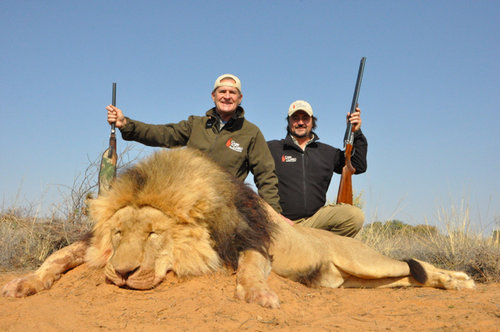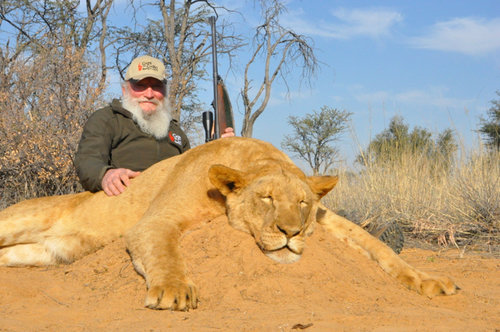LION
HUNTING
LION HUNTING
The King of beasts!"...
The lion is an apex and keystone predator.
African lions have been admired throughout history for as symbols of courage and strength



HUNTING AREA
LION / LIONESS HUNT
Baiting method: Lions are baited similarly to leopards with some differences. Larger baits are set up closer to the ground but are hung high enough so that the lions can feed with some effort, but hyenas can’t reach. Guts and stomach contents are scattered around the bait in the hope of drawing the cat in by smell. Baited lions are hunted by waiting in a blind for a lion to feed, or sometimes hunters stalk the lion on the bait. Hunters are typically successful on stalks early in the mornings as lions that fed during the night are still there at first light. Once on the bait, lions are typically easier to shoot than a leopard.
Lions are not afraid of other animals and are confident of their position in the food chain. As with all dangerous game hunts, shot placement is important when hunting lions. A good quality soft (Swift A-Frame or Barnes) in a .30 caliber will readily kill both a lion and a leopard. They are not thick-skinned and are susceptible to hydrostatic shock, sometimes dying immediately with a well-placed bullet. They are extremely dangerous when wounded, so make sure your first shot counts. Most places require a .375 minimum for all dangerous game; the bigger the better, as long as accuracy is not sacrificed. A trophy lion is not measured by the hair around its neck but rather by the size of its skull. A big mane, however, is a nice bonus. Some areas genes produce lions with thick manes, while other areas genes produce big-bodied lions with very average manes. Lions are typically hunted on a 21-day safari, but exceptions on the duration of the hunt can be made. Lions and leopards are hunted in small numbers, and available licenses or quotas are limited.
Bait animals commonly used include zebra, hippo, and impala.
Track and Stalk method: Once you hunt a lion on foot that has no fear of man and in dense vegetation, you will get a new perspective of life. On a dangerous game hunt, and especially on a lion hunt, it does not take anyone long to understand the drill prior to setting off into the bush. You will start by heading out on your safari vehicle looking for fresh tracks. The trackers have incredible abilities to spot lion tracks and to actually track the lions.
Once you find tracks, you will investigate the tracks to determine if they are fresh tracks. Your professional hunter will then have a brief discussion with you and the rest of the hunting party. He will explain the types of lion behavior when hunted and what you should anticipate during the hunt. He will also make sure you and everyone in the hunting party are aware of perfect shot placement on the lion and that everyone that participates in the hunt knows exactly what is expected from them.
You are tracking fresh tracks, and everyone is really focused on tracking down and stalking the lion. You will be walking at a brisk pace on the tracks of the lion, who will quickly sense that you are catching up with this magnificent king of beasts and that the lion knows you are getting closer to him. Sometimes the lion will start to walk in circles and sometimes in a figure eight. At this point the hunt becomes extremely dangerous, and everyone is on high alert. Even though you are the hunter, you feel as if you are being hunted. The process can sometimes carry on for a couple of hours or sometimes a couple of days. When walking or crawling through really thick brush, you realize that the lion can be waiting for you behind any of the surrounding bushes and that following the tracks in this thick brush can sometimes be suicide.
At this point your professional hunter decides if it is too dangerous to pursue the lion in the incredibly dense brush. Sometimes you have to abort the hunt and come back the next day to start the tracking again.
Once you spot the lion, he will either face you or decide to run off. In the event the lion runs off, you will give chase at a fast pace while staying on the tracks. In most cases the lion will not go too far before he beds down again. In most cases, after 2 or 3 encounters, the lion would bed down to wait for the hunters to get closer. The lion/lioness has now accepted the challenge, and it is now at its most dangerous.
You will approach slowly and circle around the lion until you have the wind in your favor and the sun from behind. Get closer to about 25-30 yards from the lion and position yourself for a clear shot. Your professional hunter will put up the shooting sticks and instruct you to take aim and wait. As soon as you, your PH, and your backup shot are ready and everyone’s sights are locked on the lion, the PH will tell you to relax, take a deep breath, and shoot when ready. At this point the lion is ready to charge at any minute and has his sights locked on you. Remember, shot placement is everything at this point. Adrenalin will be pumping as never before, and it is now up to you to lock your scope onto the lion and pull the trigger.
Regardless of where you hit the lion, immediately reload, fire another shot, and reload again. The PH and backup shooter will shoot the lion in the event of a dangerous situation should the lion attack. Once you have the lion down, your body will be shaking from excitement and adrenaline! Your dream of hunting a lion in Africa will finally become a reality! We trust that your lion hunt with us will be one of the best hunting experiences of your life!
Please note! Prior to the hunt, it will be made clear that regardless of who shoots the lion in an attack, it will be considered your trophy lion.

